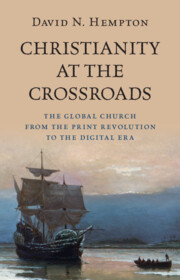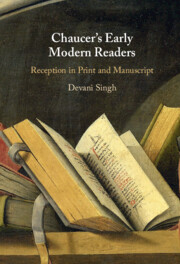Refine search
Actions for selected content:
74 results
2 - Religious Networks in the Reformation Era
-
- Book:
- Christianity at the Crossroads
- Published online:
- 19 May 2025
- Print publication:
- 31 July 2025, pp 45-75
-
- Chapter
- Export citation
Introduction
-
- Book:
- Christianity at the Crossroads
- Published online:
- 19 May 2025
- Print publication:
- 31 July 2025, pp 1-12
-
- Chapter
- Export citation
Conclusion
-
- Book:
- Selling Sexual Knowledge
- Published online:
- 24 June 2025
- Print publication:
- 10 July 2025, pp 244-249
-
- Chapter
-
- You have access
- Open access
- HTML
- Export citation

Christianity at the Crossroads
- The Global Church from the Print Revolution to the Digital Era
-
- Published online:
- 19 May 2025
- Print publication:
- 31 July 2025
17 - Ottoman Science
- from Part II - Perspectives and Methods
-
-
- Book:
- The Cambridge Companion to Ottoman History
- Published online:
- 31 May 2025
- Print publication:
- 20 March 2025, pp 236-250
-
- Chapter
- Export citation
Chapter 19 - Oratory: Persuasion in Performance
- from Part III - Genres
-
-
- Book:
- The Cambridge Companion to Nineteenth-Century American Literature and Politics
- Published online:
- 06 March 2025
- Print publication:
- 13 March 2025, pp 319-331
-
- Chapter
- Export citation
Chapter 7 - Useful Books
- from Part II - Anglophone Literary Forms
-
-
- Book:
- The Cambridge Handbook of Literature and Plants
- Published online:
- 06 February 2025
- Print publication:
- 13 February 2025, pp 131-148
-
- Chapter
- Export citation
Chapter 2 - Media Technologies, the Organisation of Knowledge, and 1870s Literary Culture
-
-
- Book:
- Nineteenth-Century Literature in Transition: The 1870s
- Published online:
- 30 January 2025
- Print publication:
- 06 February 2025, pp 43-63
-
- Chapter
- Export citation
Chapter 13 - The Printed Book in the Digital Age
-
-
- Book:
- The Cambridge Companion to Literature in a Digital Age
- Published online:
- 29 November 2024
- Print publication:
- 14 November 2024, pp 233-249
-
- Chapter
- Export citation
Chapter 11 - Page and Book Design in Dictionaries
- from Part II - Dictionaries as Books
-
-
- Book:
- The Cambridge Handbook of the Dictionary
- Published online:
- 19 October 2024
- Print publication:
- 31 October 2024, pp 216-237
-
- Chapter
- Export citation
16 - Manga Media from Analog to Digital
- from Part VIII - Forms of Distribution
-
-
- Book:
- The Cambridge Companion to Manga and Anime
- Published online:
- 07 November 2024
- Print publication:
- 31 October 2024, pp 213-225
-
- Chapter
- Export citation
Chapter 5 - Fame and Famine
-
- Book:
- The Business of English Restoration Theatre, 1660–1700
- Published online:
- 18 October 2024
- Print publication:
- 13 June 2024, pp 166-213
-
- Chapter
-
- You have access
- Open access
- HTML
- Export citation
Chapter 5 - Book Trade
- from Part II - Publishing History and Legacy
-
-
- Book:
- Jonathan Swift in Context
- Published online:
- 02 May 2024
- Print publication:
- 09 May 2024, pp 35-42
-
- Chapter
- Export citation
2 - The News Landscape
-
- Book:
- Real News about the News
- Published online:
- 09 February 2024
- Print publication:
- 01 February 2024, pp 17-36
-
- Chapter
- Export citation
Kathryn Schwartz, Book Historian of the Modern Middle East
-
- Journal:
- Review of Middle East Studies / Volume 57 / Issue 2 / December 2023
- Published online by Cambridge University Press:
- 13 March 2025, pp. 202-209
- Print publication:
- December 2023
-
- Article
-
- You have access
- HTML
- Export citation
Chapter 2 - ‘My Pen Is at the Bottom of a Page’
-
-
- Book:
- The Cambridge Companion to Byron
- Published online:
- 02 November 2023
- Print publication:
- 16 November 2023, pp 23-37
-
- Chapter
- Export citation
Chapter 1 - Comics Drawing
- from Part I - Forms
-
-
- Book:
- The Cambridge Companion to Comics
- Published online:
- 17 August 2023
- Print publication:
- 31 August 2023, pp 25-45
-
- Chapter
- Export citation
Chapter 9 - The American Revolution
- from Part III - Revolutions and Empires
-
-
- Book:
- The Nation in British Literature and Culture
- Published online:
- 20 July 2023
- Print publication:
- 10 August 2023, pp 157-173
-
- Chapter
- Export citation

Chaucer's Early Modern Readers
- Reception in Print and Manuscript
-
- Published online:
- 08 June 2023
- Print publication:
- 22 June 2023
-
- Book
-
- You have access
- Open access
- Export citation
Becoming the Muʿallim: how tradition and innovation made a Nahḍa icon
-
- Journal:
- Bulletin of the School of Oriental and African Studies / Volume 86 / Issue 2 / June 2023
- Published online by Cambridge University Press:
- 12 July 2023, pp. 241-259
- Print publication:
- June 2023
-
- Article
-
- You have access
- Open access
- HTML
- Export citation
